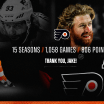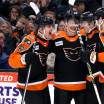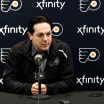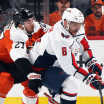The much-hyped "trading frenzy" during the NHL and the start of the free agency period have passed. They passed by in relative silence. For all the hours of television coverage and words written about who might be moving where (and for how long), the whole thing turned out to be largely a dud.
Therien's Take: Free Agency Isn't What it Used to Be
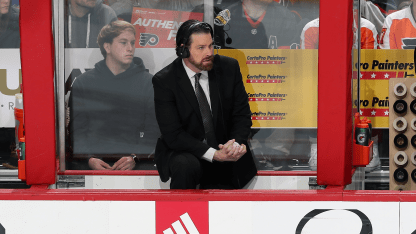
By
Chris Therien @ctherien6 / philadelphiaflyers.com
Let's talk trades first: There really haven't been many high-impact trades made, or even all that many deals where teams were able to create much cap space, at least not without accepting pennies on the dollar (a single third-round pick for Nate Schmidt?) and/or adding sweetners in the form of a team's own upper-end Draft picks in upcoming Drafts in order to convince another team to take on the contract.
There's a weird reality this offseason, in case you haven't noticed: cap space itself IS the most coveted "player" on the market, even more so than filling on-ice needs with useful players. Cap space for what? Mostly, it's money to hold back to re-sign a team's own restricted free agents after they finish their entry level or second ("bridge") deals.
The biggest name out there in trade rumors this off-season has been Winnipeg Jets winger Patrik Laine. Personally, I'd be very leery of ponying up the type of trade package it would take to trade for him.
I get it, though. He's only 22 years old. Outside of Alex Ovechkin or a healthy Steven Stamkos, there might not be a more dangerous pure shooter in the game than Laine. He's already got one 40-goal season to his credit in the NHL, and there will almost certainly be others.
There are, however, some major drawbacks. Given his goal-scoring upside and size, why would Laine NOT be untouchable, especially as the second overall pick of the Draft just four years ago? Answer: At this still-early stage of his career, he remains a bit of a one-trick pony and is streaky in executing the one thing he undeniably does very well.
These question marks have dogged the player for years, and still exist to varying degrees: Does Laine make the players around him better? Does he actually make use of his size with any consistency? Is he mentally tough enough to battle through adversity when things don't go his way? Is he coachable and emotionally mature? Does he bring a winner's no-excuses attitude?
Laine improved defensively over the past year; going from an outright liability to adequate. But I'd be hard pressed to call him a two-way, complete player. That's OK if he's scoring 35 or more like clockwork. Twice he's done that, twice he hasn't.
Then we get to the almighty cap space issue. Laine is on a bridge deal that runs out after the 2020-21 season, at which point he will be an arbitration-eligible restricted free agent. His current cap hit is $6.75 million. His next deal, assuming he has even a half-decent year, is going to cost much, much more than that. How much? Quite possibly north of the $9 million range on a long-term contract.
Lastly, what would be the trade cost? Winnipeg reportedly wants a package of high-talent, cost-controlled players -- at least one of whom is a top-four caliber defenseman -- and draft picks. There are a few teams that COULD do that (the Flyers among them), but the bottom line question is SHOULD they?
The best answer to that question: it depends on your level of risk tolerance. Offense sells tickets and merchandise; two things that will be greatly needed once we come out enough from the pandemic to have fans in the stands again.
Hockey-wise and cap management-wise, though, such an an investment is high risk. Given that there's a flat cap ceiling that is going to tie teams' hands for years to come and given that I am pretty old-school and believe strongly that it is goaltending, team defense and talented depth down the middle that are the hallmarks of a championship caliber team, I'd be more inclined to seek other ways to boost my team's scoring output.
Now let's talk free agents. Truthfully, it was a pretty underwhelming crop this year. With some exceptions, short-term deals were the order of the day in many cases. Most notably Taylor Hall signed for one year with Buffalo. The Flyers got former 60-point defenseman Erik Gustafsson for $3 million on a one-year deal. Among the notable remaining UFAs, such as Mike Hoffman, I think most will have to take one-year deals or two at the most.
There were still some overpays in salary and/or term in the marketplace. TJ Brodie to Toronto comes to mind, along with the extension Montreal gave to Josh Anderson after acquiring him via trade from Columbus). Overall, though, there weren't as many such deals because team's didn't have the cap space flexibility for the longer term.
Top stars will always get their money. Alex Pietrangelo was the one true major-impact unrestricted free agent on the market this year. Vegas got him, and then had to sell off Schmidt's contract in what was strictly a salary dump. In reality, though, the cost of doing business to add Pietrangelo was justified.
From all I have heard, Pietrangelo apparently had his short-list of possible destinations set pretty early if he was going to leave St. Louis. If you weren't on his list from the get-go, you simply weren't going to be in the game to get him. It was a bit like the John Tavares situation a couple summers ago.He could name his price and teams to consider, and it was up to the club to make it happen.
Controlling your own market price and ability to handpick the team and city where YOU most want to play is a great situation to be in if you're Alex Pietrangelo. As for the vast majority of players in the league, it really isn't that way. Not anymore, at least.
Luxury signings have largely gone away. I don't see them coming back any time soon, either. The economics of pro sports took a vicious downturn due to the pandemic, and the effects are going to be long-lasting.
Plain and simple, if you're going to be a contender, it has to be done mostly in-house through homegrown talent. You'd also better do it pretty quickly, so that you're getting a lot of production from players on their first or second contracts. Bridge deals kick the can down the road a year or two, but ultimately wind up costing the team more. Cost control is the name of the game, and you'd better be right on the mark with your scouting and development operations. If not, there could be a whole lot of lean seasons in your future.
To take your first-round draft picks and trade them repeatedly as commodities for short-term fixes -- hello, Pittsburgh Penguins, I'm talking about you in particular -- is going to bite you in the butt in the marketplace that has emerged. The immediate future in Pittsburgh may still be OK as long as Sidney Crosby, Evgeni Malkin and Kris Letang remain productive players.
But are the Penguins truly a Cup contender anymore? I'd say that window is almost closed. And once it closes, bleak days are likely ahead because the talent pool will be shallow and the effects of the flat cap will be progressive with each passing year. Their fan base may not mind the recent patchwork parade of traded first-rounders too much right now. The back-to-back Cups in 2016 and 2017 are still visible in the rear-view mirror. Thing is, time passes fast.
-
We are living in different times now. Being capped out, especially when you've got few expiring contracts, is an albatross around general managers' necks. I won't even get into leaguewide organizational considerations outside of the money for hockey operations, but the reality is that everyone has to be budget conscious in every aspect due to the decreased revenues.
The teams that will be the worst off: ones with multiple albatross contracts PLUS depleted farm systems and already-traded future first-round and second-round picks. Wanna compete year after year? Draft well, develop well, and don't get too attached to middle-tier talents by giving them long-term deals based mainly on past performance rather than projected performance over the life of the next contract.
It's a rough place to be if you're a veteran player; even an established above-average one in your late 20s or early 30s. It's also just the reality of our game's financial times.


